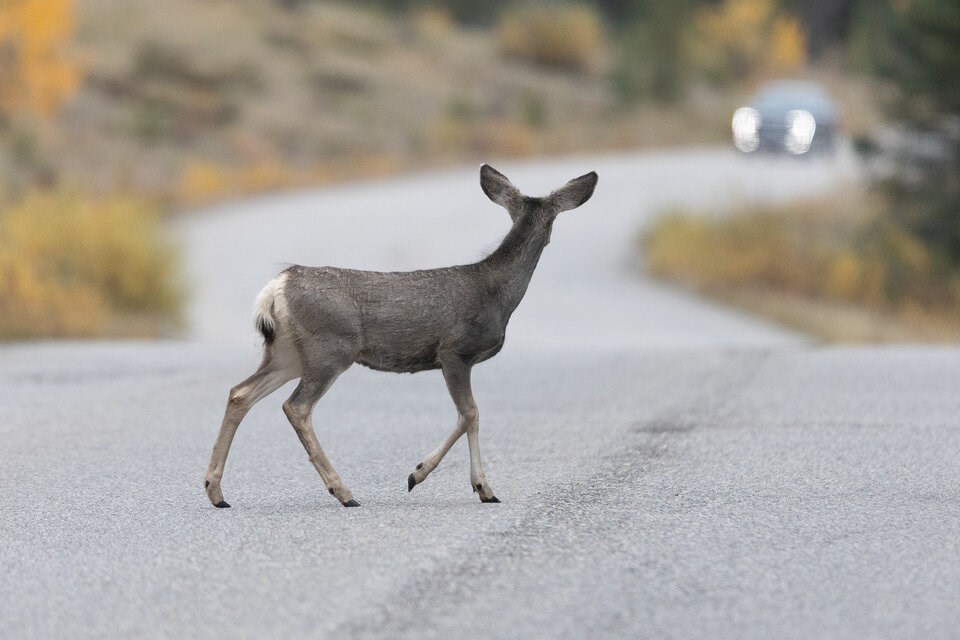The province is backing the capture, killing and testing of hundreds of urban deer across two B.C. municipalities. Their goal: find out if chronic wasting disease has spread into the city.
On Friday, the Ministry of Water, Land and Resource Stewardship said the targeted removal and testing of deer would start Feb. 18 and will run until the end of the month in the Kooteney municipalities of Cranbrook and Kimberley.
“Up to 100 deer will be removed from each community (200 deer total) for disease control and testing purposes,” confirmed a ministry spokesperson in an email.
“We will share the final number of animals removed after work is complete.”
Chronic wasting disease — also known as CWD or “zombie deer disease” — spreads through highly infectious prions, deformed proteins that accumulate in the animal's body.
Those prions pass into the environment through the urine or feces of infected animals, and once there, they can survive for decades, spreading the brain disease among deer, elk, moose and caribou.
Within 18 months of infection, the animals tend to show signs of weight loss, drooling and poor co-ordination. Every infected animal ends up dead.
The first B.C. deer confirmed infected with CWD were isolated in January 2024.
The two neighbouring cities are being targeted after four of five positive samples found over the past year were located near Cranbrook, said Jesse Zeman, executive director of the BC Wildlife Federation.
Both cities have large urban deer populations living within small home ranges and in close quarters. The ministry statement said that makes them especially prone to spreading the disease.
“We’ve kind of got a circle around Cranbrook,” said Zeman. “We could be sitting on a major outbreak and not know. The trick now is to find out.”
Zeman said learning how prevalent CWD is in the two cities is likely to require the capture and testing of more than half of each city’s deer population.
“When prevalence is really low, which it is right now, you need to drastically increase your sample size,” he said. “It’s going to be north of 100 deer in each community.”
The ministry spokesperson said the deer will be sedated with darts and then killed in a controlled setting.
“Sharpshooting is also being explored as a potential second removal option, should it be confirmed safe to do,” said the spokesperson. “Appropriate calibre and shot placement will be used to ensure humane death.”
Whatever the method, it could prove controversial. Past attempts to cull urban deer in the communities before CWD arrived led to significant push-back from some in the community.
“It’s been very controversial,” said Zeman. “There are people who are very connected with the deer that live in their yard. The flip side to that is, in those cities, they’re managing deer with car bumpers — running them over.”
CWD was first identified in captive deer in Colorado in the 1960s. Since then it has spread to 25 American states and three Canadian provinces, in many cases, decimating local ungulate populations.
Kaylee Byers, an assistant professor at Simon Fraser University who is leading a genomic mapping project that tracks CWD in B.C., said the urban testing will hopefully give her group a better understanding of how the virus is travelling in and out of the cities.
“There’s not really a lot of scientific evidence around scale, the number of removals that is effective,” she said. “But you’re definitely dealing in the hundreds.”
What scientists in B.C. do know, said Byers, is that they need to act quickly if they're going to prevent the disease from spreading elsewhere in the province or killing more animals in the future.
Past studies have shown primates (in particular squirrel monkeys) are susceptible to the disease. But no human has been reported ill with CWD.
That doesn’t mean it couldn’t happen, said Byers.
Last fall, the researcher said that if humans were found vulnerable to zombie deer disease, it could present decades later in the same way mad cow disease (which is also spread through prions) has behaved in the past.
“We don’t know if it can be passed on to people,” Byers said at the time. “We just don’t have a baseline.”
Editor's Note: This story has been updated from a previous version to include comments from the B.C. Ministry of Water, Land and Resource Stewardship.




